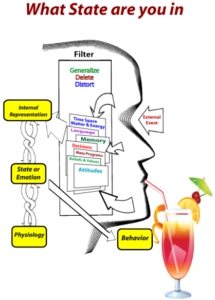 The name NeuroLinguistic Programming comes from the three areas it brings together:
The name NeuroLinguistic Programming comes from the three areas it brings together:
N -Neurology, The mind and how we think,
L -Linguistic, How we use language and how it affects us,
P -Programming, How we sequence our actions to achieve our goals.
In short, NLP is a way of exploring the relationship between how we think, how we communicate both verbally and non-verbally, and our patterns of behaviour and emotion. It works on the basis that each one of us builds our own unique “models” or “maps” of the world around us and, although such maps are genuine and real to us as individuals, no one’s “map” is fully able to represent the “real world”.
NLP is a form of therapy that can be used in conjunction with hypnosis or on its own. It is broad based and draws on concepts from many areas of psychology and psychotherapy. Influences stem from the Gestalt ‘school’, the family therapy of Virginia Satir, Ericksonian brief therapy, and humanistic psychology. There are also clear links with the fields of systems theory, behavioural psychology, and linguistics.
During therapy, we take as a starting point the belief that the client already has all the resources they need within. We work to help them identify their desired state (goals & outcomes). Then, by applying certain methods, we assist the client to alter the beliefs associated with the negative aspects of their life creating new positive results.
We have both been highly trained in the art of NLP.
